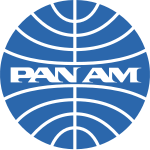
Back Pan Am AF خطوط بان أمريكان العالمية Arabic خطوط بان امريكان العالميه ARZ Пан Ам Bulgarian Pan American World Airways BS Pan American World Airways Catalan Pan American World Airways Czech Pan American World Airways Danish Pan American World Airways German Pan Am Greek
 | |||||||
| |||||||
| Founded | 14 March 1927 (as Pan American Airways) | ||||||
|---|---|---|---|---|---|---|---|
| Commenced operations | 19 October 1927 (as Pan American Airways) | ||||||
| Ceased operations | 4 December 1991 | ||||||
| Hubs |
| ||||||
| Focus cities |
| ||||||
| Frequent-flyer program | WorldPass | ||||||
| Subsidiaries |
| ||||||
| Fleet size | 226 | ||||||
| Destinations | 87 countries on six continents at its peak in 1968[1] | ||||||
| Parent company | Pan Am Corporation | ||||||
| Headquarters | |||||||
| Key people |
| ||||||
Pan American World Airways, originally founded as Pan American Airways[2] and more commonly known as Pan Am, was an airline that was the principal and largest international air carrier and unofficial overseas flag carrier of the United States for much of the 20th century. It was the first airline to fly worldwide and pioneered numerous innovations of the modern airline industry, such as jumbo jets and computerized reservation systems.[3][4] Until its dissolution on December 4, 1991, Pan Am "epitomized the luxury and glamour of intercontinental travel",[5] and it remains a cultural icon of the 20th century, identified by its blue globe logo ("The Blue Meatball"),[6] the use of the word "Clipper" in its aircraft names and call signs, and the white uniform caps of its pilots.
Founded in 1927 by two U.S. Army Air Corps majors, Pan Am began as a scheduled airmail and passenger service flying between Key West, Florida, and Havana, Cuba. In the 1930s, under the leadership of American entrepreneur Juan Trippe, the airline purchased a fleet of flying boats and focused its route network on Central and South America, gradually adding transatlantic and transpacific destinations.[7] By the mid-20th century, Pan Am enjoyed a near monopoly on international routes.[8] It led the aircraft industry into the Jet Age by acquiring new jetliners such as the Boeing 707 and Boeing 747. Pan Am's modern fleet allowed it to fly larger numbers of passengers, at a longer range, and with fewer stops than rivals.[9] Its primary hub and flagship terminal was the Worldport at John F. Kennedy International Airport in New York City.[4]
During its peak between the late 1950s and early 1970s, Pan Am was known for its advanced fleet, highly trained staff, and amenities.[3] In 1970, it flew 11 million passengers to 86 countries, with destinations in every continent except Antarctica. In an era dominated by flag carriers that were wholly or majority-owned by governments, Pan Am became the unofficial national carrier of the United States. It was a founding member of the International Air Transport Association (IATA), the global airline industry association.[10]
Beginning in the mid-1970s, Pan Am began facing a series of challenges both internal and external, along with rising competition from the deregulation of the airline industry in 1978. After several attempts at financial restructuring and rebranding throughout the 1980s, Pan Am gradually sold off its assets before declaring bankruptcy in 1991. By the time it ceased operations, the airline's trademark was the second most recognized worldwide,[3] and its loss was felt among travelers and many Americans as signifying the end of the golden age of air travel.[11] Its brand, iconography, and contributions to the industry remain well known in the 21st century.[3] The airline's name and imagery were purchased in 1998 by railroad holding company Guilford Transportation Industries, which changed its name to Pan Am Systems and adopted Pan Am's logo.
- ^ "Only Pan Am Flies to all 6 continents!". everything Pan Am. 1948. Retrieved March 27, 2022.
- ^ "Pan American World Airways, Inc". Britannica. Retrieved May 20, 2022.
- ^ a b c d Ash, Andy. "The rise and fall of Pan Am". Business Insider. Retrieved July 21, 2021.
- ^ a b Guy Norris & Mark Wagner (September 1, 1997). "Birth of a Giant". Boeing 747: Design and Development Since 1969. Zenith Imprint. pp. 12–13. ISBN 978-0-7603-0280-4.
- ^ Kickham, Debbi. "Will You Play The New Pan Am Board Game?". Forbes. Retrieved July 21, 2021.
- ^ "Pan Am Flight Crew Remembers The Era Of Flying Boats". AvStop Online Magazine. Retrieved October 7, 2020.
- ^ Cite error: The named reference
clipperswas invoked but never defined (see the help page). - ^ Gellene, Dallos (January 9, 1991). "Pan Am's Dive Began After the Government Axed Its Near-Monopoly : Airlines: The carrier had operated without competition for decades. When the floodgates opened in 1978, it couldn't cope". Los Angeles Times. Retrieved April 11, 2021.
- ^ Kingsley-Jones, Max (January 21, 2020). "Boeing 747 marks 50 years since Pan Am service debut". Flight Global. Retrieved April 10, 2021.
- ^ "IATA: A new mandate in a changed world". Airliner World. Stamford: Key Publishing. November 2011. p. 32.
- ^ "LOTS OF REASONS WHY PAN AM FAILED". The Washington Post. ISSN 0190-8286. Retrieved July 21, 2021.